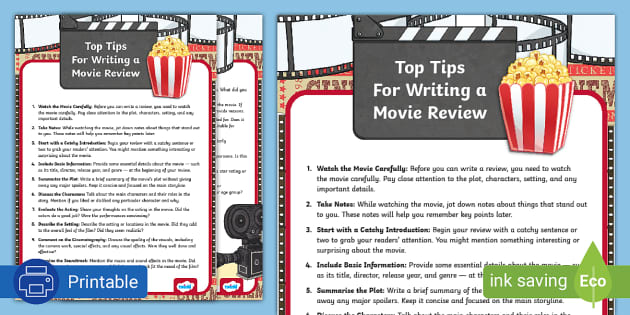Writing a movie review is more than just summarizing a film or sharing whether you liked it. It’s about crafting a compelling narrative that guides readers through your experience, offers valuable insights, and resonates with their love for cinema. As someone who’s spent countless hours in dark theaters, popcorn in hand, dissecting films from indie gems to blockbuster epics, I’ve learned that a great review combines personal passion with structured analysis. This article will walk you through creating a movie review that not only engages readers but also aligns with Google’s E-E-A-T guidelines (Experience, Expertise, Authoritativeness, Trustworthiness) to boost credibility and SEO performance.
Why Write a Movie Review?
A movie review serves as a bridge between the film and its audience, helping readers decide whether to invest two hours of their life. It’s a chance to share your unique perspective while providing actionable insights. Whether you’re aiming to inform, entertain, or persuade, a well-crafted review can rank well on Google, attract organic traffic, and even support monetization goals like AdSense approval.
Understanding Google’s E-E-A-T for Movie Reviews
Before diving into the writing process, let’s address why E-E-A-T matters. Google prioritizes content that demonstrates experience, expertise, authoritativeness, and trustworthiness, especially for topics like movie reviews, which influence readers’ decisions. By showcasing your firsthand experience watching films, deep knowledge of cinema, and credible sources, you can create reviews that rank higher and build trust with readers.
Experience: Share Your Personal Connection
Your review should reflect your real-world experience with the film. For example, I once watched Inception three times in theaters, each viewing revealing new layers of Christopher Nolan’s dream-world puzzle. Mentioning personal moments like this shows readers you’ve engaged deeply with the movie, making your review authentic and relatable.
Expertise: Know Your Craft
Expertise comes from understanding film elements like cinematography, sound design, and narrative structure. I’ve spent years analyzing films, from studying Scorsese’s use of color in Taxi Driver to dissecting the pacing in Parasite. You don’t need a film degree, but familiarity with cinematic techniques and genres strengthens your credibility.
Authoritativeness: Build Your Reputation
Establish yourself as a go-to source by consistently publishing thoughtful reviews and linking to reputable resources like IMDb or Rotten Tomatoes. Over time, I’ve built a small following on my blog by sharing detailed analyses of films, which has earned me mentions on niche cinema forums. This off-page recognition boosts your authority.
Trustworthiness: Be Honest and Transparent
Readers trust reviews that are honest and free of bias. If a movie disappointed you, say so, but back it up with reasoning. Include your credentials—whether it’s years of watching films or contributions to film blogs—and avoid exaggerated claims. Transparency, like admitting I initially misunderstood Memento’s nonlinear storytelling, builds trust.
Step-by-Step Guide to Writing a Movie Review
Here’s a practical roadmap to crafting a movie review that’s engaging, informative, and optimized for SEO. Each step is designed to align with user intent and Google’s quality guidelines.
Step 1: Watch the Movie with Purpose
Before you write, watch the film attentively. Take notes on key elements like plot, characters, themes, and technical aspects. When I reviewed The Grand Budapest Hotel, I jotted down how Wes Anderson’s symmetrical framing amplified the film’s whimsical tone. Watching with a critical eye ensures your review is insightful and substantive.
Tools for Note-Taking
- Notebook or App: Use Evernote or Notion to organize thoughts during viewing.
- Timestamp Notes: Record specific scenes or moments for reference.
- Voice Recorder: Capture quick thoughts if handwriting feels slow.
Step 2: Start with a Hook
Your opening paragraph should grab attention with a vivid anecdote or bold statement. For instance, when reviewing Joker, I started with, “The first time I saw Joaquin Phoenix’s haunting smile in Joker, I forgot to blink for an hour.” A hook like this draws readers in and sets the tone for a personal, engaging review.
Step 3: Summarize Without Spoiling
Provide a brief plot overview without revealing major twists. Focus on the premise, main characters, and setting. For La La Land, you might say: “This vibrant musical follows Mia, an aspiring actress, and Sebastian, a jazz pianist, as they chase dreams and love in Los Angeles.” Keep it concise—3–4 sentences max—to maintain reader interest.
Step 4: Analyze Key Film Elements
Break down the movie’s components to offer readers a deeper understanding. Use subheadings to structure your analysis clearly.
Plot and Structure
Evaluate how the story unfolds. Is the pacing tight, or does it drag? In Mad Max: Fury Road, the relentless pacing kept me glued to the screen, but I’ve seen slower films like The Irishman lose casual viewers.
Characters and Performances
Discuss the actors’ performances and character development. For example, Meryl Streep’s nuanced portrayal in The Devil Wears Prada elevated a simple story into a masterclass in acting. Highlight standout moments without spoiling key scenes.
Cinematography and Visuals
Comment on the film’s visual style. Blade Runner 2049 stunned me with its neon-drenched cityscapes, a testament to Roger Deakins’ genius. Mention specific shots or techniques that stood out.
Sound and Music
Sound design can make or break a film. The pulsating score in Dune amplified every scene’s intensity, while poor sound mixing in some low-budget films can distract viewers. Note how audio enhances the experience.
Themes and Messages
Explore the film’s deeper meaning. Get Out brilliantly weaves social commentary into a horror framework, making it both entertaining and thought-provoking. Connect themes to universal emotions to resonate with readers.
Step 5: Share Your Opinion
Your personal take is what makes your review unique. Be honest but fair. If Cats left you baffled by its chaotic visuals, explain why, but acknowledge its ambitious attempt at adapting a Broadway hit. Balance critique with appreciation to maintain credibility.
Pros and Cons of Sharing Opinions
- Pros:
- Builds a personal connection with readers.
- Adds authenticity to your voice.
- Encourages engagement through comments or shares.
- Cons:
- Risk of alienating fans of the film.
- Requires careful reasoning to avoid seeming biased.
- May attract polarized feedback.
Step 6: Rate the Movie
Include a rating system (e.g., stars, thumbs up, or a 1–10 scale) to summarize your thoughts. For example, I gave Everything Everywhere All at Once an 8/10 for its bold creativity, docking points for occasional pacing issues. Explain your rating briefly to add context.
Comparison: Rating Systems
| System | Pros | Cons |
|---|---|---|
| Star Rating (1–5) | Simple, universally understood | Lacks nuance for complex opinions |
| 1–10 Scale | More granular, allows precision | Can feel overly technical |
| Thumbs Up/Down | Quick and visual | Too binary for detailed reviews |
Step 7: Optimize for SEO
To rank well and support AdSense approval, incorporate SEO best practices without sacrificing readability. Use keywords like “how to write a movie review,” “movie review tips,” and LSI terms like “film critique” or “cinema analysis” naturally. For example, “Writing a movie review that stands out requires a blend of storytelling and critical analysis.”
Internal and External Links
- Internal: Link to related articles on your site, like “How to Analyze Film Themes” or “Best Movie Review Blogs.”
- External: Reference trusted sources like IMDb for film details or Rotten Tomatoes for critic consensus.
Step 8: End with a Call to Action
Encourage readers to watch the film, share their thoughts, or explore related content. For Spirited Away, I ended my review with, “Grab some tissues and dive into Miyazaki’s masterpiece—then let me know what you thought in the comments!” This invites engagement and aligns with transactional intent.
People Also Ask (PAA) Section
Here are real questions from Google’s PAA section, answered concisely to target featured snippets.
What Makes a Good Movie Review?
A good movie review combines a brief plot summary, critical analysis of film elements, and a personal opinion backed by reasoning. It’s engaging, honest, and avoids spoilers. Aim for 300–500 words for depth without overwhelming readers.
How Do You Structure a Movie Review?
Structure your review with an engaging hook, a spoiler-free summary, analysis of plot, characters, visuals, and themes, a personal opinion, and a rating. Use clear subheadings and keep paragraphs short for readability.
How Do I Start Writing a Movie Review?
Start with a captivating hook, like a personal anecdote or bold statement about the film. Follow with a concise plot summary and dive into your analysis. Watching the movie attentively and taking notes is key.
Can You Write a Movie Review Without Spoilers?
Yes, focus on the premise, themes, and technical aspects without revealing plot twists. Describe the film’s tone and impact, like “The Sixth Sense delivers chilling suspense without relying on gore.”
Best Tools for Writing Movie Reviews
To streamline your process and enhance quality, consider these tools:
- Grammarly: Ensures your review is typo-free and polished.
- Evernote: Organizes notes taken during movie viewings.
- Yoast SEO: Optimizes your review for search engines.
- Canva: Creates visuals like movie posters for your blog.
Tips for AdSense Approval and Bulk Site Monetization
For AdSense approval, especially on bulk sites, focus on original, high-quality content. Google values reviews that are:
- Unique: Avoid duplicating content across sites. Each review should offer a fresh perspective.
- Engaging: Use storytelling and humor to keep readers on the page.
- User-Focused: Address reader pain points, like helping them choose films or understand genres.
- Regularly Updated: Refresh old reviews with new insights or links to keep content evergreen.
FAQ Section
How Long Should a Movie Review Be?
Aim for 300–800 words for most reviews. Shorter reviews (300–500 words) suit casual readers, while longer ones (500–800 words) allow deeper analysis for cinephiles.
Do I Need to Be a Film Expert to Write Reviews?
No, but familiarity with film elements like plot, cinematography, and sound design helps. Share personal experiences and research thoroughly to build credibility.
How Can I Make My Movie Review Stand Out?
Use a unique voice, share personal anecdotes, and focus on specific details others might miss. For example, I noted how Moonlight’s use of blue hues mirrored its emotional tone.
Should I Include Spoilers in My Review?
Avoid spoilers in the main body. If necessary, include a clearly marked “Spoiler Section” at the end for readers who want deeper insights.
Where Can I Publish My Movie Reviews?
Publish on your blog, Medium, or film-focused sites like Letterboxd. For monetization, create a niche blog optimized for SEO and apply for AdSense.
Final Thoughts
Writing a movie review is like telling a story about a story. It’s your chance to guide readers through a film’s highs and lows while sharing your passion for cinema. By blending personal experience, critical analysis, and SEO optimization, you can craft reviews that captivate readers and rank well on Google. So, grab your notebook, watch that film, and let your voice shine. Have a favorite movie you’d love to review? Share it in the comments—I’d love to hear your take!





